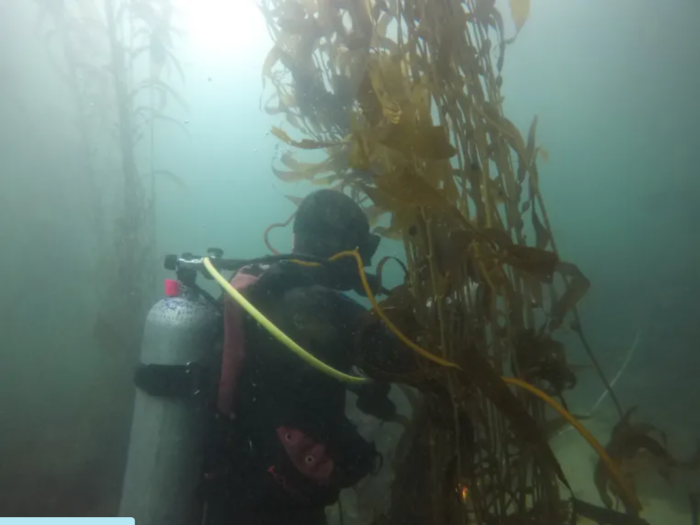
Blog: Finding Sanctuary – What’s up with kelp forests in Monterey National Marine Sanctuary By: Lisa Wooninck
Blog: Finding Sanctuary – What’s up with kelp forests in Monterey National Marine Sanctuary By: Lisa Wooninck

A diver counts kelp at Hopkins/Cannery Row in June. (Steve Lonhart/NOAA)
By: Lisa Wooninck
Published: Santa Cruz Sentinel, August 19, 2023
Kelp forests are valuable and iconic habitats of the central coast of California. Indeed, kelp forests are truly iconic to Monterey Bay National Marine Sanctuary and are prominently featured at the Monterey Bay Aquarium’s Giant Kelp Forest Exhibit, delighting visitors since 1984, when the aquarium opened. A simple and elegant kelp blade serves as the logo of the Monterey Bay Aquarium and communicates very powerfully the unique status of kelp.
Kelp forests serve as habitat to more than 700 species of animals and plants that depend on them, including the threatened southern sea otter. However, patterns indicate that kelp forests are declining globally and the mechanisms driving those changes are an intense area of scientific research. Closer to home, bull kelp forests in northern California off the Sonoma and Mendocino counties have declined by 90%, with only weak signs of recovery in limited areas.
Kelp forests not only serve as habitat for an amazing diversity of marine life, they are also the engine for a productive coastal economy. Ecosystem services provided to our local, regional and global communities include recreational and commercial fisheries, ecotourism, kelp for abalone mariculture, and carbon fixing and storage (helping to mitigate for human caused climate change), to name a handful. The status of Monterey Bay sanctuary’s kelp forests and the ecosystem services they provide have raised concern for the recovery of these forests and increased interest in their restoration.
In some areas of Monterey Bay sanctuary, kelp has declined over the last 10 years to historically low levels. These kelp declines coincided with multiple events including marine heatwaves, seastar disease outbreaks and a dramatic increase in purple sea urchins. In many central and northern California rocky reefs, purple sea urchins transformed once expansive kelp forests into sea urchin barrens that have lowered abundances and diversity of algae, invertebrates and fishes.
Yet, in contrast, kelp forests in other areas of the sanctuary appear to be holding their own against the voracious urchin hordes. This patchwork of kelp- and urchin-dominated habitats within the sanctuary presents an opportunity to understand the mechanisms supporting natural resistance to urchin grazing, since some areas have had kelp forests fairly consistently for the past decade. Other areas such as along historic Cannery Row, once overgrazed by urchins, are showing signs of natural recovery and this month kelp seems as thick as ever. There are also areas exhibiting neither resistance nor recovery, and these may help scientists determine where restoration efforts, if warranted, could be located (or avoided) with the highest likelihood of success.

While the pattern of abundant kelp in southern California, a patchwork of kelp in central California, and minimal kelp in northern California is well observed, the reasons for such a pattern remain elusive, and warrant greater scrutiny to better understand how kelp forests persist, or not, in different areas of the state. For now, our sanctuary is a mixed bag, but therein lies a great opportunity to understand what drives these dynamics, and how to adaptively manage these resources for future generations. The Monterey Bay sanctuary is actively engaging with scientists, resource managers, recreational divers and kelp advocates from the California Department of Fish and Wildlife, UC Santa Cruz, the Monterey Bay Aquarium, Giant Giant Kelp Restoration Project, and Ocean Protection Council (to name a handful). Similar to the purpose of the state’s Kelp Restoration and Management Plan, we support scientific research and monitoring projects designed to help inform resource managers on solutions to kelp loss and foster meaningful partnerships with Indigenous Communities, community-based organizations and impacted stakeholders.
Lisa Wooninck became the superintendent of NOAA’s Monterey Bay National Marine Sanctuary in 2021. She has a doctorate in ecology and evolutionary biology, and marine biology from UC Santa Barbara. She can be reached at lisa.wooninck@noaa.gov. To learn more about the sanctuary, visit https://montereybay.noaa.gov/.
